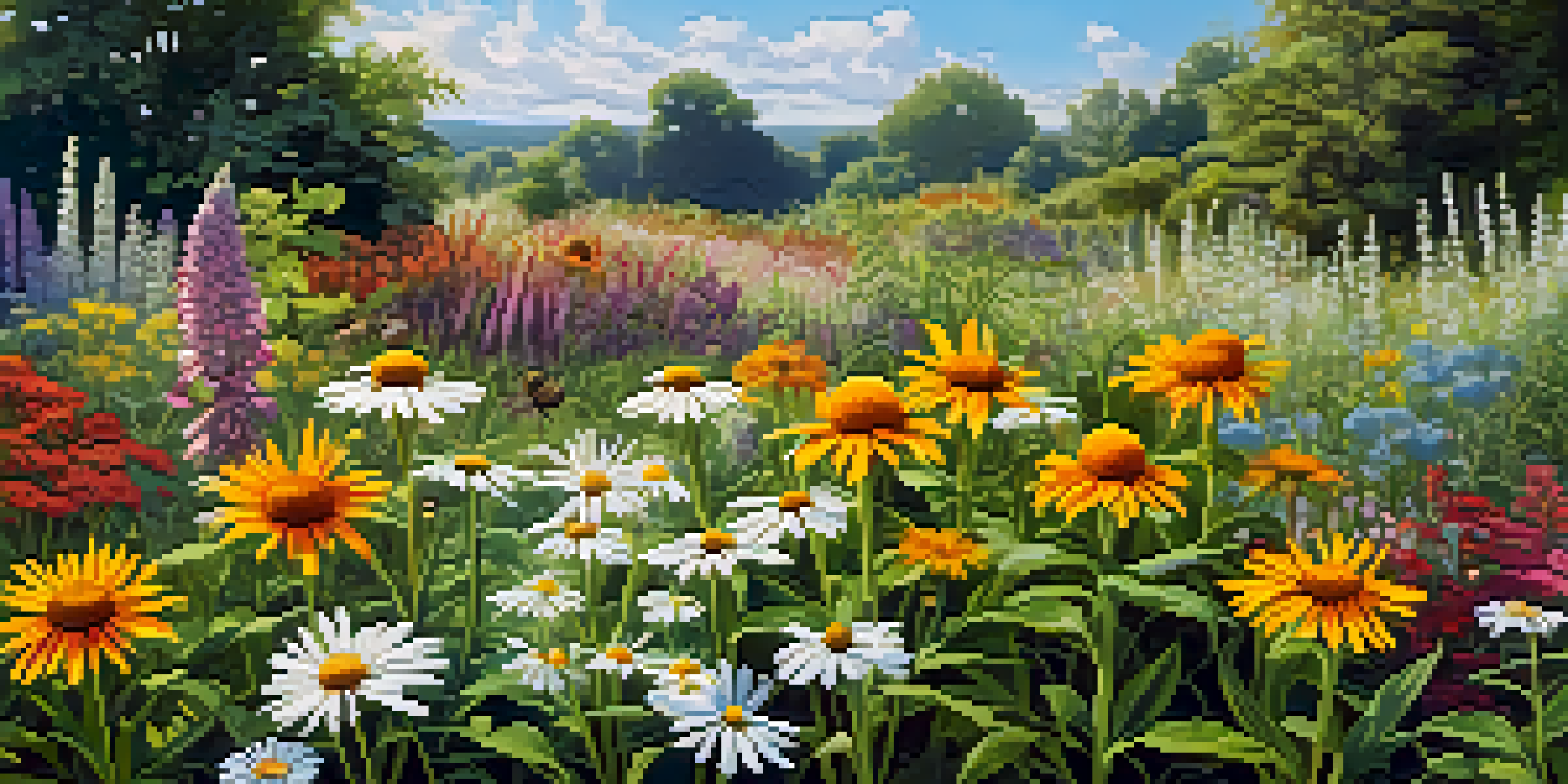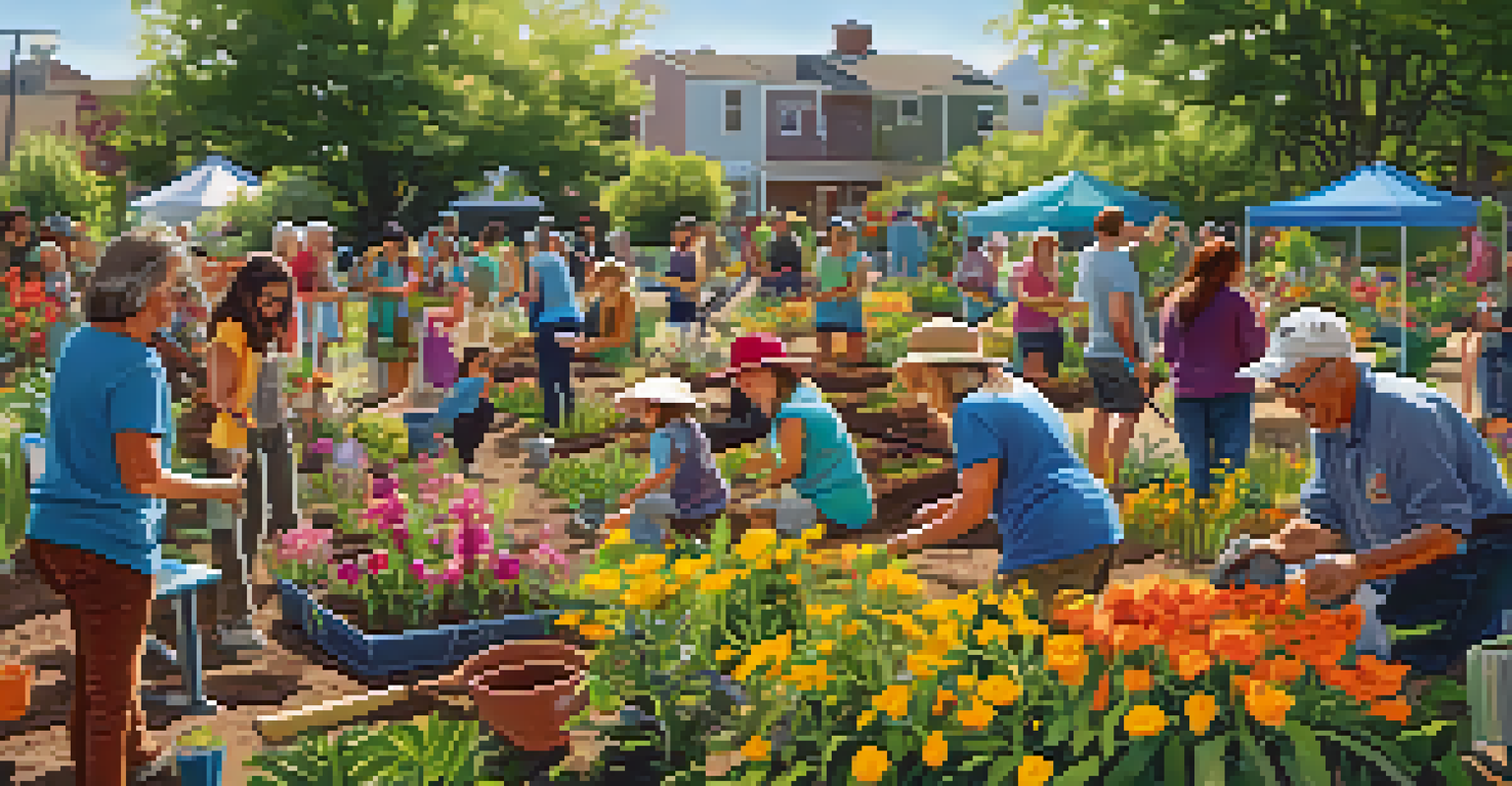Planting for Pollinators: Best Practices for Biodiversity

Understanding the Importance of Pollinators
Pollinators, such as bees, butterflies, and hummingbirds, play a crucial role in our ecosystems. They are responsible for the pollination of many crops and flowering plants, which contributes significantly to food production and biodiversity. Without these little helpers, many of the fruits and vegetables we enjoy would simply not exist, leading to a less diverse diet and ecosystem.
The hum of bees is the voice of the garden.
Their decline due to habitat loss, pesticide use, and climate change underscores the urgency of supporting their populations. By creating pollinator-friendly environments, we can help reverse this trend. Simple actions, like planting native flowers, can have a profound impact on local biodiversity and the health of our planet.
Understanding the importance of pollinators is the first step towards becoming an advocate for biodiversity. By appreciating the role they play, we can better appreciate our responsibility in nurturing their habitats.
Choosing Native Plants for Your Garden
One of the best ways to support pollinators is to plant native species that have evolved alongside them. Native plants provide the most suitable nectar and pollen sources for local pollinators, ensuring they have the food they need to thrive. For instance, native wildflowers like coneflowers and milkweeds are not only beautiful but also vital for attracting butterflies and bees.

Moreover, native plants are often more resilient to local pests and diseases, requiring less maintenance and fewer chemicals. This creates a healthier garden environment for both pollinators and humans. By choosing plants that are native to your area, you’re not just beautifying your space; you’re also fostering a sustainable ecosystem.
Pollinators Are Essential for Ecosystems
Pollinators like bees and butterflies are crucial for food production and biodiversity, highlighting the need for their protection.
Incorporating native plants is a powerful way to contribute to biodiversity. It helps create a natural habitat that supports a variety of wildlife, ensuring that pollinators have the resources they need year-round.
Creating a Diverse Planting Strategy
Diversity is key when it comes to planting for pollinators. A variety of flowering plants that bloom at different times throughout the growing season ensures that pollinators have a steady food supply. For example, planting early bloomers like crocuses in spring alongside late bloomers like asters in the fall creates a continuous source of nectar.
If we kill off the bees, we will die from hunger.
Additionally, incorporating plants of various heights and structures creates different habitats that can attract a wider range of pollinators. Some pollinators prefer open spaces, while others thrive in sheltered areas. By mixing plant types, you can cater to the needs of different species, enhancing your garden's appeal.
By embracing diversity in your planting strategy, you create a vibrant ecosystem that not only supports pollinators but also adds visual interest to your garden. It’s a win-win for both nature and aesthetics!
Designing Pollinator-Friendly Habitats
Designing your garden with pollinators in mind can be an enjoyable and creative process. Start by identifying sunlit areas where pollinators are likely to thrive, as most need warmth and light. Incorporating features like water sources, nesting sites, and shelter can also enhance the habitat for these beneficial insects.
For example, leaving some areas of your garden a bit wild can provide natural nesting sites for solitary bees. You can also install insect hotels, which offer a cozy home for various pollinator species. Providing different environments within your garden helps create a welcoming haven.
Native Plants Support Local Pollinators
Choosing native plants ensures pollinators have the right food sources, creating a sustainable environment in your garden.
Ultimately, a well-designed pollinator-friendly habitat not only benefits the insects but also enriches your gardening experience. You’ll find joy in watching these creatures thrive in a space you’ve carefully crafted for their needs.
Minimizing Pesticide Use for Pollinator Health
One of the most significant threats to pollinators comes from pesticides. These chemicals can be harmful not only to the pests they target but also to beneficial insects like bees and butterflies. By minimizing or eliminating pesticide use in your garden, you can create a safer environment for pollinators to flourish.
Instead of relying on chemicals, consider using integrated pest management (IPM) strategies, which focus on prevention and natural controls. For instance, introducing beneficial insects like ladybugs can help keep pest populations in check without harming pollinators. Additionally, maintaining plant health through proper watering and pruning can reduce the likelihood of pest issues.
Choosing organic and natural solutions can greatly enhance the health of your garden ecosystem. By being mindful of pesticide use, you contribute to a safer environment for pollinators and help ensure their survival.
Engaging Your Community for Pollinator Conservation
Creating a pollinator-friendly garden can be even more impactful when you engage with your community. Share your knowledge and experiences with neighbors, schools, or local gardening clubs to inspire collective action. Organizing community planting days or workshops can help spread awareness about the importance of pollinators.
Collaboration can amplify your efforts; by working together, you can create larger habitats that benefit pollinators on a broader scale. Consider starting a community garden that focuses on native plants and biodiversity. This not only supports pollinators but also fosters a sense of community and shared responsibility.
Community Action Enhances Conservation
Engaging with your community in pollinator conservation efforts can create larger habitats and foster a shared commitment to biodiversity.
Engaging with your community not only enhances your local environment but also builds connections with others who care about nature. Together, you can make a significant difference in supporting pollinators and promoting biodiversity.
Monitoring and Supporting Pollinator Populations
Once you've created a pollinator-friendly space, it's important to monitor and support the populations that visit. Observing the types of pollinators in your garden can provide valuable insights into their health and behaviors. You might notice different species thriving at different times, giving you clues about what plants are most effective.
Participating in citizen science projects, such as monitoring pollinator sightings, can contribute to larger research efforts aimed at understanding pollinator populations. These initiatives often provide resources and guidance on how to observe and document your findings.

By taking an active role in monitoring pollinator populations, you not only enhance your own gardening practices but also contribute to the global effort to protect these vital creatures. Every observation counts in the quest to understand and support biodiversity.